“As a law enforcement officer, my fundamental duty is to serve the community; to safeguard lives and property; to protect the innocent against deception, the weak against oppression or intimidation, and the peaceful against violence or disorder; and to respect the constitutional rights of all to liberty, equality, and justice…”1
So begins the Law Enforcement Code of Ethics that was adopted by the IACP at the 64th Annual IACP Conference and Exposition in 1957. Since its introduction, many agencies have adopted the code to state their own mission and commitment to the communities they serve.
In taking this agreed-upon oath, police officers can stand united as they fulfill the duties acknowledged within the code of ethics. In these harsh times of a global pandemic and civil unrest, many officers have reflected back on this code to remind themselves why they chose the law enforcement profession and how they can proudly enact their commitment to the communities they serve through public service and personal behavior during the work day.
Companies offering products and services to law enforcement have also noticed the reform being demanded of the policing field, not only regarding management and policy, but also in the tools being used in daily police work. Although the world seemed to have paused during the recent pandemic, the advancement of technology and new ideas have not. Therefore, these companies have been able to look at the items they are offering—for in-the-field and at-the-office needs—and adjust them to meet the demands of officer accountability and effectiveness in an evolving profession.
In the Field
With common duties of controlling traffic, responding to emergency calls, delivering warrants, resolving disputes, and submitting incident reports, an officer has multiple interactions with the public in a single day and must be equipped with tools that provide transparency to the public by holding officers accountable of their actions.
Headquartered in Chicago, Illinois, Motorola Solutions offers a variety of public safety solutions that keep officers and communities safe while enhancing transparency. One of these solutions is the recently released WatchGuard V300 continuous operation body-worn camera.
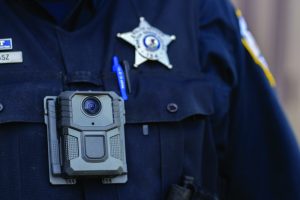
Answering customers’ needs for an extended battery life for body-worn cameras, Motorola Solutions offers the WatchGuard V300 so that an officer is able to capture a video recording even if their time in the field has been extended. The swappable battery packs and 128 GB of memory ensures ease of use and helps officers focus on their work in the field even beyond a 12-hour shift, rather than needing to return to the office to swap their camera for a newly charged one.
The body-worn camera also boasts patented Record-After-the-Fact technology. With Record-After-the-Fact enabled, no longer do agencies need to utilize pre-event recording or triggering to ensure incident recording are not missed. If enabled by a system administrator, this technology allows video to be recovered from an incident days after it occurred. Following an event, a time frame can be selected to capture video from the past—even when a recording was not automatically triggered or the record button was not pressed.
Motorola Solutions’ vice president of video security and analytics sales, Matt Brady, said, “The combination of these technologies has been incredibly impactful in ensuring safety and accountability between law enforcement and the communities they serve.”2
Offering further transparency options, the WatchGuard V300 body-worn camera can also be integrated with the WatchGuard 4RE in-car video system, allowing for the capture of synchronized video of an incident from multiple vantage points.
In the search for reform within the policing field, use of force and firearms are common topics during police interactions with community members. The Canton, Ohio–based Tufloc, one of the Esmet family of companies, strives to create products that keep communities safe, while also maintaining proper storage and security of firearms and other valuables. Tufloc supplies the military, law enforcement, security, and retail markets with gun racks for vehicles and buildings, lockers and lockboxes, and high-security locks, as well as security drawers for SUVs and cruisers.
Tufloc’s recently developed gun rack for police vehicles, the X-Lock, utilizes an improved gun lock that allows users quick, one-handed access when the need arises. The innovative design features locking arms that automatically adjust to a tight, secure fit when the gun is pressed into place. Custom-designed for every make and model of gun, the X-Lock can be mounted in many different positions within the vehicle, taking up less space than bulky safes. They are operated with a key or can be opened with a switch utilizing the vehicle’s battery power.
After receiving positive feedback from the X-Lock vehicle rack, the company decided to create a variation for the home to keep guns locked and easily accessible while keeping them secure and visible. “The vehicle gun rack didn’t revolutionize the gun rack market,” said Mike Waryas, president of Esmet. “It is an improvement allowing officers access to the firearms faster when time is essential. The residential gun rack is revolutionary.”3
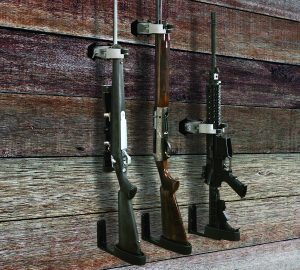 |
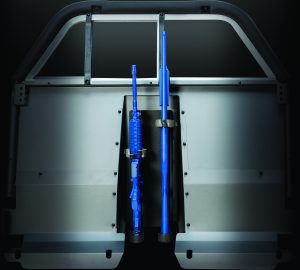 |
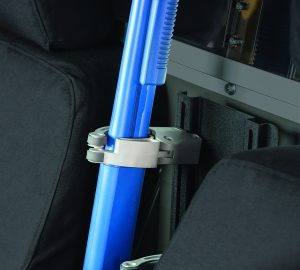 |
Providing both comfort and function during routine tasks, 5.11 Tactical, based out of Irvine, California, is a well-known name for complete uniform solutions. According to David Hein, vice president of professional at 5.11, the catalogue of offered apparel and gear are dependable, comfortable, and wash-and-wear friendly while in the office, out in the field, or off duty.4

Stemming from the functionality and demand for the 5.11 Stryke Pants, 5,11 wanted to create a uniform option that provided the same level of off-duty function and comfort in an on-duty event at a cost-effective price point. Thus, the company is offering the 5.11 Stryke Patrol Duty Uniform (PDU). Designed to stand up in the harshest patrol environments, the PDU is crafted from patented 4.84-ounce and 6.8-ounce Flex-Tac mechanical stretch fabrics and is Teflon treated for stain, soil, and moisture resistance.
Hein states that a mechanical stretch, poly/cotton patrol uniform was not on the market prior to 5.11’s introduction of the PDU. Now, there are a variety of styles and designs of pants and shirts that can be utilized to best fit the needs of the consumer.
At the Office
At the forefront of the movement to bring change to the field is an officer’s behavior in the field and the review process at the office following the event. Approaching the topic of personnel management and early intervention in the law enforcement field is the Chicago, Illinois–based Benchmark Analytics.
In collaboration with research partners led by the University of Chicago, as well as analytic specialists and technology developers, Benchmark Analytics has created an evidence-based police force management and early intervention system—the Benchmark Blueprint. The all-in-one solution enables agencies to capture and aggregate all officer performance data in an easy-to-use software-enabled system. Administrators can analyze the data for early, preventative intervention and provide customized officer support with specific case action plans.
The Benchmark Blueprint includes three analytics-driven platforms: Benchmark Management System, First Sign Early Intervention, and Case Action Response Engine.
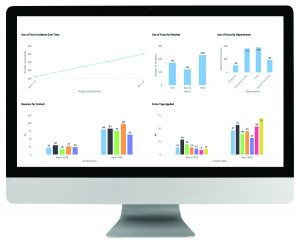
The Benchmark Management System features seven integrated modules that have been identified as essential for capturing critical data for departmental reporting. By centralizing all of an agency’s operational data points in one location, supervisors have the ability to review data, analyses, and progress over a duration of time.
Designed to flag the need for intervention early on so leadership can take preventative action before off-track behavior becomes problematic, First Sign Early Intervention features four comprehensive, easy-to-navigate EIS dashboards that capture important performance and behavior data supported by evidence-based research, take into account total productivity relative to signs indicative of problematic behavior, and provide risk-level breakdowns from all viewpoints. This allows supervisors to pinpoint where to reduce exposure to rising liability issues.
“We have entered a new era of police reform with First Sign,” said Benchmark Analytics Chief Executive Officer Ron Huberman. “Agencies can now take advantage of methodical, data-driven systems to intervene with officers who are engaged in problematic conduct, while simultaneously identifying and supporting officers who are successfully on track.”5
Once a pattern of off-track behavior is identified through First Sign Early Intervention, the Case Action Response Engine is implemented. This proactive and targeted intervention support platform enables agencies to facilitate, track, and document a plan of action to support officers who have been cited for poor behavior, while also fully automating critical track points and follow-up measures necessary to demonstrate everything that has been done to support and discipline off-track officers. The platform features research-based, analytics-driven case management modules for officer specific intervention.
As companies work to create cost-effective and functional updates to the daily tools officers use in the field and at the office, they are providing solid products and technologies that allow law enforcement leaders to create new policies that uphold the concluding lines within the IACP’s Law Enforcement Code of Ethics:
“I know that I alone am responsible for my own standard of professional perforce and will take every reasonable opportunity to enhance and improve my level of knowledge and competence. I will constantly strive to achieve these objectives and ideals, dedicating myself before God to my chosen profession…law enforcement.”6
Notes:
1 IACP, “Law Enforcement Code of Ethics.”
2 Matt Brady (vice president sales, video security and analytics, Motorola Solutions), email interview, August 14, 2020.
3 Michael Waryas (president, Esmet), email interview, August 31, 2020.
4 David Hein (vice president of professional, 5.11 Tactical), email interview, August 17, 2020.
5 Ron Huberman (chief executive officer, Benchmark Analytics), email interview, August 3, 2020; Nick Montgomery (chief research officer, Benchmark Analytics), email interview, August 3, 2020.
6 IACP, “Law Enforcement Code of Ethics.”
| Source List | |
|---|---|
|
Duty Equipment/Accessories |
|
|
|
|
|
Radios |
|
|
|
|
|
Report Writing
|
|
|
CrimeSoft Inc.
|
|
|
Weapon Storage/Security
|
|
|
|
|


